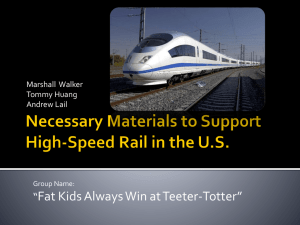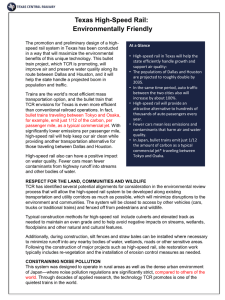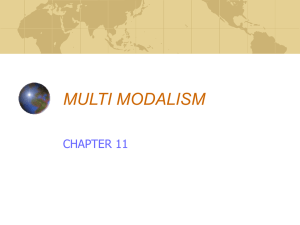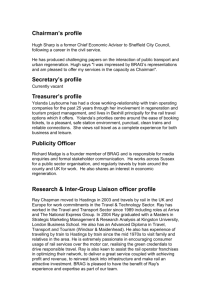Planning for a sustainable future in Australian cities
advertisement
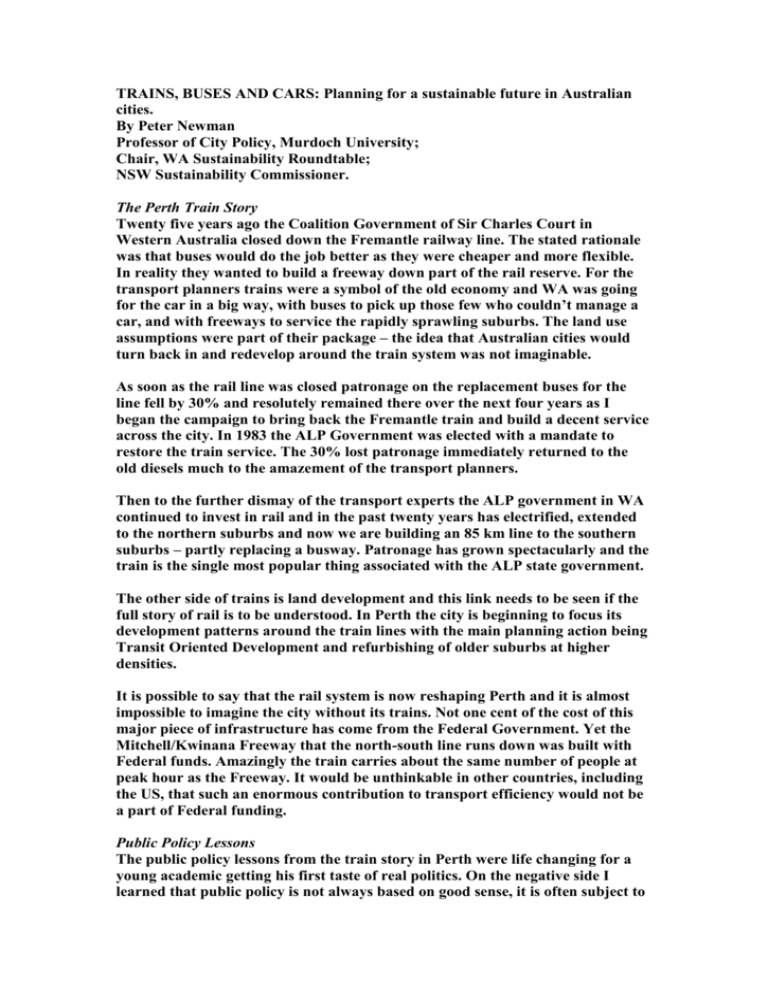
TRAINS, BUSES AND CARS: Planning for a sustainable future in Australian cities. By Peter Newman Professor of City Policy, Murdoch University; Chair, WA Sustainability Roundtable; NSW Sustainability Commissioner. The Perth Train Story Twenty five years ago the Coalition Government of Sir Charles Court in Western Australia closed down the Fremantle railway line. The stated rationale was that buses would do the job better as they were cheaper and more flexible. In reality they wanted to build a freeway down part of the rail reserve. For the transport planners trains were a symbol of the old economy and WA was going for the car in a big way, with buses to pick up those few who couldn’t manage a car, and with freeways to service the rapidly sprawling suburbs. The land use assumptions were part of their package – the idea that Australian cities would turn back in and redevelop around the train system was not imaginable. As soon as the rail line was closed patronage on the replacement buses for the line fell by 30% and resolutely remained there over the next four years as I began the campaign to bring back the Fremantle train and build a decent service across the city. In 1983 the ALP Government was elected with a mandate to restore the train service. The 30% lost patronage immediately returned to the old diesels much to the amazement of the transport planners. Then to the further dismay of the transport experts the ALP government in WA continued to invest in rail and in the past twenty years has electrified, extended to the northern suburbs and now we are building an 85 km line to the southern suburbs – partly replacing a busway. Patronage has grown spectacularly and the train is the single most popular thing associated with the ALP state government. The other side of trains is land development and this link needs to be seen if the full story of rail is to be understood. In Perth the city is beginning to focus its development patterns around the train lines with the main planning action being Transit Oriented Development and refurbishing of older suburbs at higher densities. It is possible to say that the rail system is now reshaping Perth and it is almost impossible to imagine the city without its trains. Not one cent of the cost of this major piece of infrastructure has come from the Federal Government. Yet the Mitchell/Kwinana Freeway that the north-south line runs down was built with Federal funds. Amazingly the train carries about the same number of people at peak hour as the Freeway. It would be unthinkable in other countries, including the US, that such an enormous contribution to transport efficiency would not be a part of Federal funding. Public Policy Lessons The public policy lessons from the train story in Perth were life changing for a young academic getting his first taste of real politics. On the negative side I learned that public policy is not always based on good sense, it is often subject to powerful lobbies, and it was not engaging of the public in any way. But on the positive ledger it was amazing to see how public opinion could be mobilised and could change the priorities of a government, despite the bias of its advisors. It was in fact good politics for the government to have a visionary infrastructure project as its core focus while dealing with the daily bread and butter issues of health and education and police. These lessons were invaluable as I have found that many cities around the world have faced the same issues. Across the globe the road/bus lobby have been presenting the same ideas: everything a train can do a bus can do better and cheaper; and car dependent suburbs are the only real option that the public want to see in our cities. They are wrong on both the transport and the land development front, and I now can show why in numbers where before I was just following my instincts (see books listed at the end of the article). The arguments for redevelopment around transit at higher densities to vitalise centres and corridors, is now pretty obvious as a public policy. Transit Oriented Development (TOD) is a major planning concept being worked through in every Australian city. Everyone can see that it is cheaper to develop where the infrastructure is mostly in place and especially where an area needs revitalising. The economic, social and environmental outcomes can be demonstrated and are listed in all the strategic plans across all Australian cities. However it is still not clear that transport planners (and other advisors) really see what is the value of trains in Australian cities. The public can see it but the experts still get lost. Why trains? Trains are important because they are not flexible, they are fixed. This means they are mostly very reliable and mostly faster than buses because they do not get caught up in traffic. In our studies trains average around 45 kph and buses 25 kph. This means that if you want to compete with cars then the only way would be to use buses for short trips and trains down segregated corridors. Trains also deliver higher capacity as they can carry 50,000 per hour compared to buses on bus lanes at around 5 to 7000 per hour and a freeway lane of just 2,500 people per hour. This also explains why freeway lanes fill up so quickly after a road is built, and why car dependent areas devote so much extra space to automobile movement and parking. Trains therefore are able to provide a level of certainty for developers that no other infrastructure can do. They are fixed, reliable, high capacity and fast, therefore they attract development around them. It is possible to build your life around a train and hence to build a city around them. This does not mean people wouldn’t want to use every other mode for particular journeys. It just means that the train builds the structure and the other modes can supplement. If you build the city around the car and bus you don’t get the same structure. The fetish with flexibility in transport planning has created car dependence with sub standard bus services. Flexible transport is a signal for sprawl and decentralisation. Such a city creates chaotic origins and destinations and thus traffic, endless growth in traffic. Fixed transit systems (mostly rail) are a signal for centres to be built around the walkable environments created by the concentration of people walking to and from stations. The certainty of their fixed nature is a signal for long term investment. Data from cities around the world show that when rail systems are built back into cities then there is a significant reduction in car use. The reason is called ‘transit leverage’. It seems that for every new km of rail use created it replaces around 5km of car use. This seems to be due to how some people using the rail service may give up a car and hence don’t have it for other trips, how people combine trips so they pick up shopping on the way home from the train, and also how some people move house or work so they can make better use of the train and can hence walk to many things. The Subiaco Centre has been recently rebuilt around a new station. It has been a boost for residential and commercial development and has increased patronage by 100% in the first year after opening. A recent developer came to Perth with a $90 million fund to build TOD around stations as the investment in the network will guarantee higher profits within a kilometre of any station. The future American cities are now showing an historic reversal of their car growth; whilst transit is growing car use has flattened out for nearly a decade. This is a combination of new transit investment that was begun almost in desperation as freeways filled and traffic growth seemed insatiable and also a reversal in the patterns of urban growth: cities have begun turning back in everywhere. There are around 100 rail projects happening in the US and in almost every case they are closely associated with development of land at higher densities around the stations. Critical to this is a combination of Federal funding and local funding often by cities voting to raise a special sales tax. Denver is a classic example of this reversal. It was built as a car dependent city and in the 90’s its transit system of flexible buses carried less than one percent of the transport task. Over a ten year period a community group developed the concept of FASTRACKS with six new rail lines servicing most major corridors. In November 2004 the Denver regional community voted for a sales tax that together with Federal and State funds will build the US$4 billion system. As soon as the concept was made and well before any line looked like being opened the development of land around future stations began to take off. Most urban development now looks like being focussed in TOD’s. Denver is being focussed and transformed into a far less car dependent city. Vancouver has shown this transition even more spectacularly. Its SKYTRAIN has been the focus of development. Redevelopment in the city centre has been a major proportion of all building. The result is that fringe development has almost stopped and in particular young people have flocked into the urban core where they can walk to most activity. Vancouver appears to be the first city region which can show there are now fewer cars than they had ten years ago. The city is wealthier but it has been decoupled from car use and ownership. The rationale for why this is probably a good idea for all cities is not hard to make, we’ve all heard it for years. Greenhouse and oil vulnerability are now especially big reasons for providing more transport options that can be less car dependent and less dependent on imported fossil fuels. But the economics is very persuasive too. Our numbers show that car dependence is a big waste of money in a city. Car dependent cities use 10 to 17% of their city wealth just getting around (in some families this can be as high as 40%) compared to transit oriented cities where transport is just 5 to 8% of city wealth. It is not hard to see why the wealthy in Australian cities now live in transport rich inner and central city locations and the poor are increasingly the ones trapped in car dependence. What must we do? There are few cities contemplating closing down their rail system today. Newcastle has just done that though its probably against local wishes and may be reversed if the replacement bus system does as well as the Fremantle experiment. Most cities are contemplating how to extend their rail systems. But there is no clear model of how to do this. I would suggest we need to do the following. 1. Complete the strategic planning of all Australian cities which has been happening over the past few years. These have generally tried to lesson car dependence as their main intent though the extension of rail systems has been mostly on paper and mostly been very curtailed under pressure from transport advisors still pushing for flexible bus systems. Long term visionary projects need to be embraced and planned. 2. Develop a new public-private financial model for how these visionary projects can be funded. This needs to involve a land value capture mechanism that can ensure some of the increased real estate value is transferred into the building of the train line. Superannuation firms can feed into such a mechanism as they have the certainty of investment. No such mechanism for building trains and TOD’s has been created like exists for building toll roads, though even a decade ago such a mechanism did not exist for them either. Development Corporations or state government land development agencies could provide this mechanism. 3. Create a Federal funding process that can facilitate the building of urban rail/TOD projects. This should be done in partnership with the mechanism suggested above. The Better Cities projects from the Keating Government were the closest that the Federal Government has come to providing such project funding in cities though this never involved Transport funding, it was based in Housing. It is also important to involve the private sector, especially superannuation funds, as they are the ones with substantial capital looking for long term good value projects. Just relocation of a large part of present Federal funding into a Sustainable Cities fund would begin the process (eg the First Home Owners Grant is totally untargeted). Other sustainability factors such as greenhouse, water and biodiversity could be funded through focussing environment funding. Conclusion The story of rail and transit-oriented development in Australian cities is only just beginning to unfold. The Perth experience has been a good one in showing that it can be good politics, good for the community and good for business. The main blockage remains the professional advisors who are stuck in a mode of anti-rail from which we must shake free. Peter Newman is Professor of City Policy at Murdoch University in Perth and was heavily involved in the campaign to save the Fremantle Rail Line and then to upgrade the rail system and extend it. In recent years he has worked with the Department of Premier and Cabinet in Western Australia on the development of a Sustainability Strategy and the NSW Government as a Sustainability Commissioner. His books include: ‘Sustainability and Cities: Overcoming Automobile Dependence’ (with Jeff Kenworthy), Island Press, 1999; and ‘Back on Track: Rethinking Australian and New Zealand Transport Policy’ (with Philip Laird, Jeff Kenworthy and Mark Bachels),UNSW Press, 2003.



